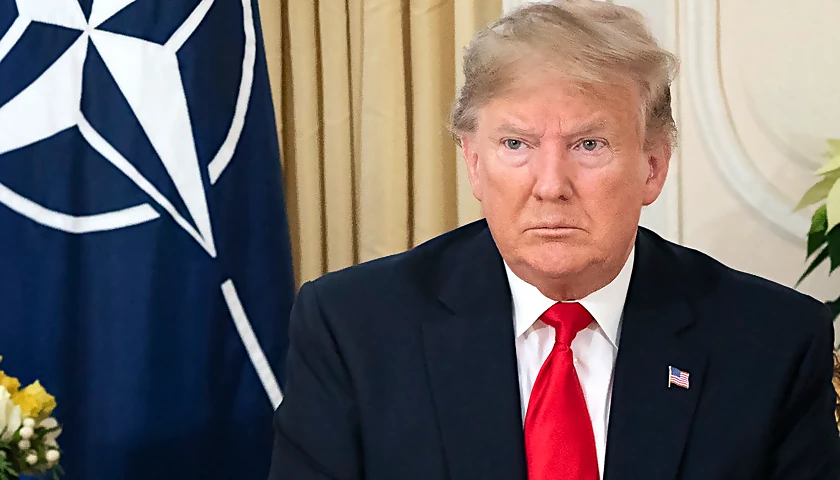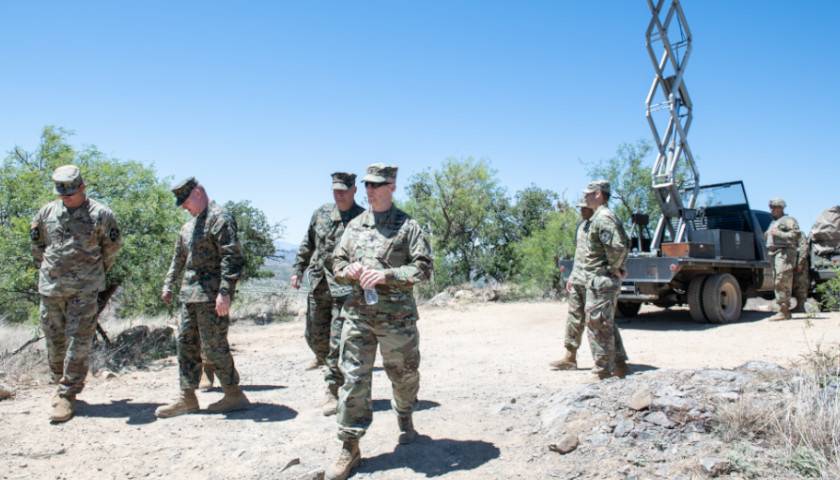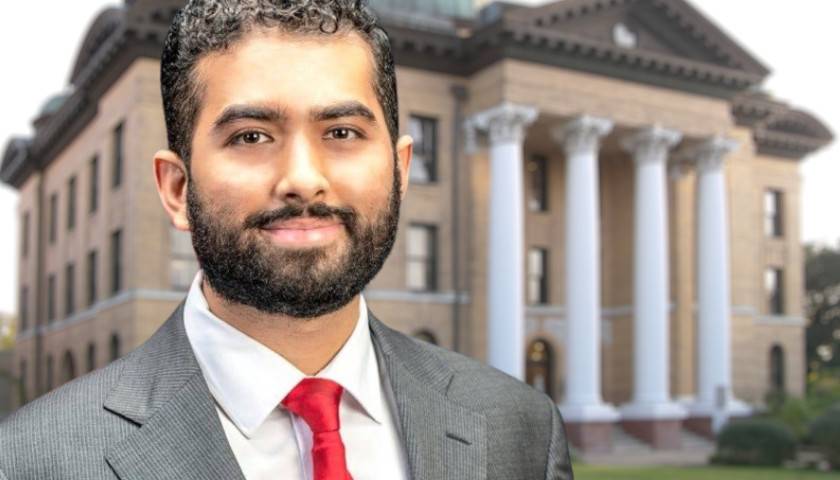by Julie Kelly
Top officials at the Department of Justice are downplaying recently disclosed documents showing FBI agents were authorized to use deadly force during their 2022 raid of Donald Trump’s Florida estate, Mar-a-Lago.
Responding to Trump’s claim that “Joe Biden was locked & loaded ready to take me out & put my family in danger,” FBI Director Christopher Wray said the bureau was following “standard operating procedure” as it executed a search warrant on Aug. 8, 2022, regarding classified material that the former president was holding at Mar-a-Lago.
While noting that Trump was not present during the raid, Attorney General Merrick Garland dismissed Trump’s claim as “false” and “dangerous.” Garland said the same language was used in a later search warrant seeking classified documents President Biden was storing in various locations.
But critics argue that there was nothing ordinary about the Mar-a-Lago raid, in which more than 30 FBI agents descended on Trump’s Palm Beach estate, potentially creating a dangerous situation with the armed Secret Service agents on site.
“There was zero reason to create an unnecessary, even one in a thousand chance, of a blue-on-blue situation with firearms,” former Secret Service agent and political commentator Dan Bongino said on his podcast. “The FBI, DOJ, and management of the Secret Service effed this up royally.”
Even as the DOJ presents its actions as business as usual, the newly released documents and other public records suggest the department’s actions entered uncharted territory. While the department claims that all citizens must be treated equally, critics note that no former president was ever the subject of an FBI search warrant before Trump.
A recently discovered Department of Defense memo suggests that the federal government may well have had copies of the documents in Trump’s possession, also raising questions about the need for the raid. The content of those documents has not been disclosed but, critics ask, if Trump was not retaining copies of information that threatened national security, what was the need for an armed raid?
Many on the right see the Mar-a-Lago raid as part of a broader effort by the Department of Justice to intimidate its political enemies. They say it is part of a larger pattern that includes the armed morning raid on the home of Trump associate Roger Stone in 2019, the arrest of anti-abortion activist Mark Houck by dozens of armed agents in 2022 a year after he was accused of pushing someone outside a Philadelphia clinic, and the DOJ’s aggressive efforts to find and charge to date more than 1,400 people connected to the Jan. 6 protest at the Capitol.
The recent court disclosures also underscore the very different treatments the department has accorded to Trump and the Biden family.
Trump, who has asserted that his presidential authority empowered him to retain and declassify documents, got a surprise nine-hour raid a few months before announcing his plans to run for reelection.
President Biden, who never had the authority to declassify or take home classified records as a senator or vice president, received the courtesy of at least two consensual FBI searches, presumably unarmed.
IRS whistleblower Joseph Ziegler, who has worked on tax cases involving Biden’s son Hunter, has testified that Hunter Biden’s lawyers were tipped off that investigators had probable cause to search his Northern Virginia storage unit.
Trump’s attorneys are now asking Judge Aileen Cannon, who is presiding over Special Counsel Jack Smith’s espionage and obstruction case against Trump in Florida, to prohibit Smith from using any of the materials seized during the Mar-a-Lago raid at trial. The FBI sought the warrant as part of its attempt to recover classified records, including national defense materials, which Trump supposedly took with him at the end of his presidency.
The FBI’s application for the warrant contained false information, the attorneys argue, and the raid violated even the very broad terms of the warrant. To make their case to the judge, Trump’s team on May 21 filed a copy of the FBI’s plan to execute the warrant, which disclosed details about how agents were instructed to conduct the raid.
The operations order, known as an FD-888, indicated the almost undercover nature of the raid. Agents were advised to wear “unmarked polo or collared shirts” and keep their badges, credentials, and equipment “concealed.”
Agents were also told to be equipped with “Standard Issue Weapons, Ammo, [and] Handcuffs.” One team was told to bring “medium and large sized bolt cutters.” A lock-picking team would be on site to open the doors of guest rooms if Mar-a-Lago staff did not cooperate. (It is unclear why an investigator would have probable cause to believe Trump stored secrets in the guest rooms of the resort area of the estate.)
Another section of the order addressed a possible response if the Secret Service attempted to impede the search or if Trump showed up that day. (Trump, at the time, was residing at his Bedminster, New Jersey, home for the summer.)
“Should FPOTUS [Former President of the United States] arrive at MAL [Mar-a-Lago], FBI [agents] will be prepared to engage with FPOTUS and USSS [U.S. Secret Service] Security Team,” the order read.
In a partially redacted portion of the plan, agents were advised to “engage” with an unidentified Secret Service contact “should USSS provide resistance or interfere with FBI timeline or accesses.”
Dan Bongino faulted the Secret Service for permitting armed police into Mar-a-Lago. “What the hell was the Secret Service management thinking, letting the FBI in there with guns? It was a protected facility.”
The inclusion of the use of deadly force policy in the raid plan prompted widespread outrage among Republicans, including the former president. The House Judiciary Committee has since sent a letter to Garland asking for more records related to the search including communications between the FBI and Secret Service in advance of the raid.
Others insisted the deadly force language was nothing to be alarmed about. After this reporter disclosed that language on May 21, FBI Director Christopher Wray issued a statement late on May 21 to that effect: “The FBI followed standard protocol in this search as we do for all search warrants, which includes a standard policy statement limiting the use of deadly force. No one ordered additional steps to be taken and there was no departure from the norm in this matter.”
Others argue, however, that in the case of an unprecedented raid against a former president and leading contender for the Republican nomination for president at the time, Wray should have considered “additional steps” and a “departure from the norm.”
“This type of event has never happened to a full time Protectee of the USSS,” Charles Butt, an 18-year special agent of the Secret Service now retired, told RealClearInvestigations by email last month. “All of this never should have happened in a reasonable environment.”
In a separate statement, Garland claimed the lethal force language was also used in the search of Joe Biden’s residence in 2022, which resulted in the discovery of several classified files, according to Special Counsel Robert Hur’s final report.
But while Trump faces 40 federal criminal charges and the possibility of years in prison for any conviction, Hur, after finding Biden had willfully retained and shared classified material stretching back to the 1970s, concluded Biden should not be charged as a jury would sympathize with “an elderly man with a poor memory.”
Hur’s report makes no mention of an FBI document related to the consensual searches of Biden’s home. Efforts to reach Hur for confirmation were unsuccessful.
After Garland characterized Trump’s comments about the use of lethal force as “extremely dangerous,” Smith filed a May 24 motion asking Cannon to impose a partial gag order on Trump that essentially would prohibit him from continuing to publicly criticize the FBI in the classified documents case.
Smith said his request is “necessary because of several intentionally false and inflammatory statements recently made by Trump that distort the circumstances under which the Federal Bureau of Investigations planned and executed the search warrant at Mar-a-Lago.” Smith complained that Trump’s comments about the raid “create a grossly misleading impression about the intentions and conduct of federal law enforcement.”
Both sides are set to clash over the gag order and the legality of the raid during a hearing in Cannon’s courtroom later this month.
Contrary to claims the raid followed standard protocols, additional court documents, media reports, and congressional testimony demonstrate the unusual nature of the process.
Prosecutors and investigators disagreed on how to pursue the investigation from the start. According to a 2023 report in the Washington Post, Jay Bratt, who initially led the early stages of the investigation, wanted to obtain a search warrant in early May 2022 – just three months after National Archives officials informed the DOJ they had found papers with classified markings contained in 15 boxes Trump’s team turned over the archives in January 2022. (Bratt is now one of Smith’s lead prosecutors in the matter.)
FBI agents working out of the Washington field office – not the proper jurisdiction of southern Florida where the alleged crimes occurred – pushed back on Bratt’s quick trigger. The agents “viewed a Mar-a-Lago search in May as premature and combative, especially given that it involved raiding the home of a former president,” the Post disclosed.
Bratt settled for a subpoena for more documents. Along with three FBI agents, Bratt personally visited Mar-a-Lago on June 3, 2022, to collect 37 records responsive to the subpoena.
Far from attempting to obstruct the investigation, Trump delayed his planned trip to Bedminster to greet the DOJ team. “Whatever you need, just let us know,” he told them. At one point, according to a court document, Trump overruled his own attorney and allowed Bratt to view the area where dozens of boxes of presidential and personal materials were stored.
Despite Team Trump’s cooperation with the DOJ, Bratt spent the next few months pushing for a search warrant for Mar-a-Lago, but key FBI officials continued to resist. The main resistance came from Steven D’Antuono, head of the Washington FBI field office at the time. D’Antuono repeatedly locked horns with Bratt and George Toscas, deputy assistant attorney general for the National Security Division, whose fingerprints also are on the FISAgate scandal to spy on Trump’s 2016 presidential campaign and the Hillary Clinton email investigation.
Toscas, in what appears to be a deviation from normal protocol, sent D’Antuono an email on Aug. 2, 2022 instructing him to move forward with getting a judge to approve the warrant. D’Antuono told the House Judiciary Committee in a 2023 interview that he “put his foot down” and continued to argue that the search should be consensual.
“I kind of got, not upset, but it’s like, you’re talking about my agents? Like they’re my agents, not yours,” D’Antuono testified he told Toscas. “They’re mine. I just – we have a different plan for this, my agents. So don’t tell me what my agents – I didn’t say this, but in the back of my mind, I was like, don’t tell me what my agents want to do because my agents tell me [something] completely different.”
But D’Antuono was overruled by Paul Abbate, deputy director of the FBI. And on Aug. 5, 2022, Florida Magistrate Judge Bruce Reinhart signed the warrant via WhatsApp encrypted chat.
Despite being thwarted by his higher-ups at the FBI, D’Antuono said he wanted to notify Trump’s attorney at the time, Evan Corcoran, before the FBI team arrived at Mar-a-Lago; Bratt refused the request even though D’Antuono said, “We usually go to the attorneys first” prior to executing any search. The FBI’s initial plan also indicated that Trump’s attorney would be notified on Aug. 8 and “request collaboration and assistance.”
But that did not happen. According to the FD-888, 30 agents out of the Washington and Miami FBI field offices arrived at Mar-a-Lago on Aug. 8 at 8:59 a.m. An unidentified individual attempted to contact Corcoran about 15 minutes later, but he was not reached until around 9:40 a.m. as agents were preparing to conduct the search. It is unclear when Corcoran arrived.
In another oddity, the FBI disclosed that a prosecutor for the U.S. attorney’s office in southern Florida was present during the search; prosecutors generally do not participate in raids, as they instead handle charging decisions after evidence is collected as a result of a search. Further, the prosecutor would lose immunity if the search was declared unlawful.
That appears to be a possibility. The warrant allowed agents to search Trump’s office as well as “all storage rooms, and all other rooms or areas within the premises used or available to be used by FPOTUS and his staff and in which boxes or documents could be stored.”
But Trump’s lawyers argue that FBI agents exceeded the scope of the warrant by searching the private suite of former first lady Melania Trump and the couple’s son, Barron, who was 16 at the time.
An FBI photo log demonstrates agents entered and took photographs of items inside both bedrooms. “There was no factual basis for the agents to rummage through rooms not specified in the warrant and, not surprisingly, they seized nothing from these other rooms,” Trump’s attorneys wrote.
Some records related to the search remain under seal, including grand jury testimony of a Secret Service agent. Judge Cannon previously indicated she would allow for the unsealing of grand jury materials if necessary, so more revelations as to how the raid was planned and conducted could be forthcoming.
Documents filed on June 11 add more context to the execution of the raid. It appears the Secret Service point of contact was only informed of the warrant roughly two hours before agents arrived at Mar-a-Lago. Contrary to what the DOJ attempts to portray as a “cooperative” effort between the two law enforcement agencies, FBI agents used a bolt cutter to open the lock of the storage area where boxes were housed rather than wait for a key.
Agents mishandled files from the start; Smith recently admitted the sequence of evidence inside the boxes is not in the original order and that some alleged classified records do not match the cover sheet used as a placeholder to indicate where the classified record was found.
Which leads to this question: Was the unprecedented and potentially dangerous raid of the former president’s home only the beginning of what now appears to be a botched case?
– – –
Julie Kelly is an independent journalist covering the weaponization of the U.S. Government against her citizens, Follow Kelly on Twitter / X.
Photo “Mar-A-Lago” by Mar-A-Lago




